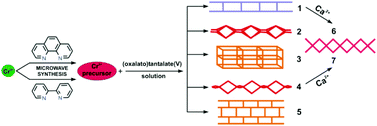Five new oxalate complexes of chromium(III), [Hphen][Cr(phen)(C2O4)2]·2H2O (1), [Cr(phen)2(C2O4)][Cr(phen)(C2O4)2]·3H2O (2), [Cr(phen)2(C2O4)]NO3·H2C2O4·H2O (3), [Cr(bpy)2(C2O4)][Cr(bpy)(C2O4)2]·3H2O (4) and [Cr(bpy)2(C2O4)]NO3·1/2H2C2O4·4H2O (5) (phen = 1,10-phenanthroline, bpy = 2,2′-bipyridine), were prepared by using an (oxalato)tantalate(V) solution as a source of oxalate ligands. The compounds contain either the discrete mononuclear [Cr(L)2(C2O4)]+ cation [L = phen (3); L = bpy (5)] or the discrete mononuclear [Cr(L)(C2O4)2]− anion [L = phen (1)], or both types of mononuclear ions [L = phen (2); L = bpy (4)]. The crystal structures are dominated by the hydrogen-bonding and π⋯π-stacking interactions that give rise to the overall two- (compounds 1, 2, 4, 5) or three-dimensional (compound 3) architectures. Compounds 2 and 4 represent a borderline case between isostructurality and non-isostructurality; they exhibit an analogous packing of the cation and the anion units, but the crystallization water molecules occupy different positions – due to a difference in size between the phen and bpy ligands. The influence of steric factors is evident also in the case of 3 and 5, which, despite very similar chemical formulae, exert a completely different packing of the constituents. By the self-assembling of 1 and 4, used as building blocks in the reaction with calcium(II) cations, the heterobimetallic polymeric compounds {[CaCr2(phen)2(C2O4)4]·5H2O}n (6) and {[CaCr2(bpy)2(C2O4)4]·0.83H2O}n (7) were obtained. The crystal structure of 7 is reported: the [Cr(bpy)(C2O4)2]− unit, through the two oxalate groups, acts as a chelating ligand towards Ca cations, resulting in heterometallic one-dimensional double zigzag chains, formed of diamond-shaped units. The characterization of the compounds obtained was accomplished by the spectroscopy and thermal analysis methods.


 Please wait while we load your content...
Please wait while we load your content...